Development of Clean-Label Protein- and Fiber-Enriched Dry Pretzels Using Hemp Seed By-Products
Abstract
1. Introduction
2. Materials and Methods
2.1. Materials
2.2. Methods
2.2.1. Technological Process for Dry Pretzel Preparation
2.2.2. Physicochemical Characteristics and Proximate Composition
2.2.3. Determination of Total Polyphenol Content (TPC)
2.2.4. Determination of Total Flavonoid Content (TFC)
2.2.5. Determination of Antioxidant Activity (DPPH Assay)
2.2.6. Determination of Antioxidant Activity (ABTS Assay)
2.2.7. Check-All-That-Apply (CATA) Sensory Analysis
2.2.8. Color Evaluation
2.2.9. Statistical Analysis
3. Results
3.1. Physicochemical Characteristics of Pretzels
3.2. Proximate Composition of Pretzels
3.3. Total Polyphenol, Flavonoid and Antioxidant Activity of Pretzels
3.4. Sensory Evaluation of Pretzels
3.4.1. Sensorial Data Analysis Based on CATA Results
3.4.2. Sensorial Data Analysis Based on Principal Coordinate Analysis (PCoA)
3.5. Color Parameters
3.6. Interrelationships Between Hemp Seed Cake Addition and Pretzel Quality Attributes
4. Conclusions
Author Contributions
Funding
Institutional Review Board Statement
Informed Consent Statement
Data Availability Statement
Acknowledgments
Conflicts of Interest
References
- Singh, R.; Das, R.; Sangwan, S.; Rohatgi, B.; Khanam, R.; Peera, S.K.P.G.; Das, S.; Lyngdoh, Y.A.; Langyan, S.; Shukla, A.; et al. Utilisation of Agro-Industrial Waste for Sustainable Green Production: A Review. Environ. Sustain. 2021, 4, 619–636. [Google Scholar] [CrossRef]
- Covaliov, E.; Capcanari, T.; Radu, O.; Boiștean, A. Oil Seed Meals and Pasta: A New Dimension in by-Product Valorization. AUDJG-Food Technol. 2024, 48, 9–26. [Google Scholar] [CrossRef]
- Serrapica, F.; Masucci, F.; Raffrenato, E.; Sannino, M.; Vastolo, A.; Barone, C.M.A.; Di Francia, A. High Fiber Cakes from Mediterranean Multipurpose Oilseeds as Protein Sources for Ruminants. Animals 2019, 9, 918. [Google Scholar] [CrossRef] [PubMed]
- Vichare, S.A.; Morya, S. Exploring Waste Utilization Potential: Nutritional, Functional and Medicinal Properties of Oilseed Cakes. Front. Food Sci. Technol. 2024, 4, 1441029. [Google Scholar] [CrossRef]
- Fu, Z.; Zhong, L.; Tian, Y.; Bai, X.; Liu, J. Identification of Cellulose-Degrading Bacteria and Assessment of Their Potential Value for the Production of Bioethanol from Coconut Oil Cake Waste. Microorganisms 2024, 12, 240. [Google Scholar] [CrossRef]
- Zboon, K.K.A. Indoor Air Pollution Due to Household Use of Olive Cake as a Source of Energy. Int. J. Environ. Waste Manag. 2017, 19, 248. [Google Scholar] [CrossRef]
- Lakshmi Durga, M.; Pal, L.; Wahid, A. Production of Biochar from Oilseed Residue (Deoiled Cakes): State-of-the-Art. In From Biomass to Biobased Products; Jacob-Lopes, E., Queiroz Zepka, L., Rodrigues Dias, R., Eds.; IntechOpen: London, UK, 2024; ISBN 978-1-83769-002-2. [Google Scholar]
- Nath, A.; Das, K.; Dhal, G.C. Global Status of Agricultural Waste-Based Industries, Challenges, and Future Prospects. In Agricultural Waste to Value-Added Products; Neelancherry, R., Gao, B., Wisniewski, A., Jr., Eds.; Springer Nature Singapore: Singapore, 2023; pp. 21–45. ISBN 978-981-99-4471-2. [Google Scholar]
- Mohanty, A.; Rout, P.R.; Dubey, B.; Meena, S.S.; Pal, P.; Goel, M. A Critical Review on Biogas Production from Edible and Non-Edible Oil Cakes. Biomass Conv. Bioref. 2022, 12, 949–966. [Google Scholar] [CrossRef] [PubMed]
- Siddiqi, R.A.; Singh, T.P.; Rani, M.; Sogi, D.S.; Bhat, M.A. Diversity in Grain, Flour, Amino Acid Composition, Protein Profiling, and Proportion of Total Flour Proteins of Different Wheat Cultivars of North India. Front. Nutr. 2020, 7, 141. [Google Scholar] [CrossRef]
- Juul, F.; Vaidean, G.; Parekh, N. Ultra-Processed Foods and Cardiovascular Diseases: Potential Mechanisms of Action. Adv. Nutr. 2021, 12, 1673–1680. [Google Scholar] [CrossRef]
- Popkin, B.M.; Ng, S.W. The Nutrition Transition to a Stage of High Obesity and Noncommunicable Disease Prevalence Dominated by Ultra-processed Foods Is Not Inevitable. Obes. Rev. 2022, 23, e13366. [Google Scholar] [CrossRef]
- Dicken, S.J.; Batterham, R.L. Ultra-Processed Food: A Global Problem Requiring a Global Solution. Lancet Diabetes Endocrinol. 2022, 10, 691–694. [Google Scholar] [CrossRef]
- Capcanari, T.; Covaliov, E.; Negoița, C. Harnessing Hemp (Cannabis sativa L.) Seed Cake Proteins: From Concentrate Production to Enhanced Choux Pastry Quality. Foods 2025, 14, 567. [Google Scholar] [CrossRef]
- Capcanari, T.N.; Covaliov, E.F.; Negoița, C.L. Hemp (Cannabis sativa L.) Seeds Nutritional Aspects and Food Production Perspectives: A Review. Food Syst. 2024, 7, 52–58. [Google Scholar] [CrossRef]
- Sciacca, F.; Virzì, N.; Pecchioni, N.; Melilli, M.G.; Buzzanca, C.; Bonacci, S.; Di Stefano, V. Functional End-Use of Hemp Seed Waste: Technological, Qualitative, Nutritional, and Sensorial Characterization of Fortified Bread. Sustainability 2023, 15, 12899. [Google Scholar] [CrossRef]
- Bonacci, S.; Di Stefano, V.; Sciacca, F.; Buzzanca, C.; Virzì, N.; Argento, S.; Melilli, M.G. Hemp Flour Particle Size Affects the Quality and Nutritional Profile of the Enriched Functional Pasta. Foods 2023, 12, 774. [Google Scholar] [CrossRef] [PubMed]
- Leonard, W.; Zhang, P.; Ying, D.; Fang, Z. Hempseed in Food Industry: Nutritional Value, Health Benefits, and Industrial Applications. Comp. Rev. Food Sci. Food Safe 2020, 19, 282–308. [Google Scholar] [CrossRef]
- Montero, L.; Ballesteros-Vivas, D.; Gonzalez-Barrios, A.F.; Sánchez-Camargo, A.D.P. Hemp Seeds: Nutritional Value, Associated Bioactivities and the Potential Food Applications in the Colombian Context. Front. Nutr. 2023, 9, 1039180. [Google Scholar] [CrossRef]
- Tănase Apetroaei, V.; Pricop, E.M.; Istrati, D.I.; Vizireanu, C. Hemp Seeds (Cannabis sativa L.) as a Valuable Source of Natural Ingredients for Functional Foods—A Review. Molecules 2024, 29, 2097. [Google Scholar] [CrossRef] [PubMed]
- Atalay, S.; Jarocka-Karpowicz, I.; Skrzydlewska, E. Antioxidative and Anti-Inflammatory Properties of Cannabidiol. Antioxidants 2019, 9, 21. [Google Scholar] [CrossRef]
- Capcanari, T.; Covaliov, E.; Negoița, C.; Siminiuc, R.; Chirsanova, A.; Reșitca, V.; Țurcanu, D. Hemp Seed Cake Flour as a Source of Proteins, Minerals and Polyphenols and Its Impact on the Nutritional, Sensorial and Technological Quality of Bread. Foods 2023, 12, 4327. [Google Scholar] [CrossRef]
- Yano, H.; Fu, W. Hemp: A Sustainable Plant with High Industrial Value in Food Processing. Foods 2023, 12, 651. [Google Scholar] [CrossRef]
- Rajasekhar, K.; Fausto, S.; Byron, S.; Frank, C.; Chris, B.; Rodney, C.; Eric, W. Characterization of the Nutritional and Safety Properties of Hemp Seed Cake as Animal Feed Ingredient. Int. J. Livest. Prod. 2021, 12, 53–63. [Google Scholar] [CrossRef]
- Yuan, D.; Cao, C.; Kong, B.; Sun, F.; Zhang, H.; Liu, Q. Micronized Cold-Pressed Hemp Seed Cake Could Potentially Replace 50% of the Phosphates in Frankfurters. Meat Sci. 2022, 189, 108823. [Google Scholar] [CrossRef]
- Rusu, I.E.; Marc, R.A.; Mureşan, C.C.; Mureşan, A.E.; Mureşan, V.; Pop, C.R.; Chiş, M.S.; Man, S.M.; Filip, M.R.; Onica, B.-M.; et al. Hemp (Cannabis sativa L.) Flour-Based Wheat Bread as Fortified Bakery Product. Plants 2021, 10, 1558. [Google Scholar] [CrossRef] [PubMed]
- Kowalski, S.; Mikulec, A.; Litwinek, D.; Mickowska, B.; Skotnicka, M.; Oracz, J.; Karwowska, K.; Wywrocka-Gurgul, A.; Sabat, R.; Platta, A. The Influence of Fermentation Technology on the Functional and Sensory Properties of Hemp Bread. Molecules 2024, 29, 5455. [Google Scholar] [CrossRef]
- Association of Official Analytical Chemists. Food Composition, Additives, Natural Contaminants, 17th ed.; Horwitz, W., Ed.; Official Methods of Analysis of AOAC International; AOAC International: Arlington, VA, USA, 2000; ISBN 978-0-935584-67-7. [Google Scholar]
- Bolea, C.A.; Grigore-Gurgu, L.; Aprodu, I.; Vizireanu, C.; Stănciuc, N. Process-Structure-Function in Association with the Main Bioactive of Black Rice Flour Sieving Fractions. Foods 2019, 8, 131. [Google Scholar] [CrossRef] [PubMed]
- AACC. International Approved Methods of American Association of Cereal Chemists, 10th ed.; American Association of Cereal Chemists: St. Paul, MN, USA, 2000. [Google Scholar]
- Hussain, M.; Saeed, F.; Niaz, B.; Afzaal, M.; Ikram, A.; Hussain, S.; Mohamed, A.A.; Alamri, M.S.; Anjum, F.M. Biochemical and Nutritional Profile of Maize Bran-enriched Flour in Relation to Its End-use Quality. Food Sci. Nutr. 2021, 9, 3336–3345. [Google Scholar] [CrossRef] [PubMed]
- Makkar, H.P.S. Measurement of Total Phenolics and Tannins Using Folin-Ciocalteu Method. In Quantification of Tannins in Tree and Shrub Foliage; Springer: Dordrecht, The Netherlands, 2003; pp. 49–51. ISBN 978-90-481-6428-8. [Google Scholar]
- Spranger, I.; Sun, B.; Mateus, A.M.; Freitas, V.D.; Ricardo-da-Silva, J.M. Chemical Characterization and Antioxidant Activities of Oligomeric and Polymeric Procyanidin Fractions from Grape Seeds. Food Chem. 2008, 108, 519–532. [Google Scholar] [CrossRef]
- Lin, J.; Zhou, W. Role of Quercetin in the Physicochemical Properties, Antioxidant and Antiglycation Activities of Bread. J. Funct. Foods 2018, 40, 299–306. [Google Scholar] [CrossRef]
- Arnao, M.B.; Cano, A.; Alcolea, J.F.; Acosta, M. Estimation of Free Radical-quenching Activity of Leaf Pigment Extracts. Phytochem. Anal. 2001, 12, 138–143. [Google Scholar] [CrossRef]
- Heussen, F.; Holthuysen, N.; Kremer, S.; Rason, J.; Worch, T. Beyond Liking: Innovative Approach Using CATA to Better Understand Consumer’s Associations to Products. Food Qual. Prefer. 2023, 108, 104860. [Google Scholar] [CrossRef]
- Varela, P.; Ares, G. Sensory Profiling, the Blurred Line between Sensory and Consumer Science. A Review of Novel Methods for Product Characterization. Food Res. Int. 2012, 48, 893–908. [Google Scholar] [CrossRef]
- Wrolstad, R.E.; Smith, D.E. Color Analysis. In Food Analysis; Nielsen, S.S., Ed.; Food Science Text Series; Springer International Publishing: Cham, Switzerland, 2017; pp. 545–555. ISBN 978-3-319-45774-1. [Google Scholar]
- Janse, R.J.; Hoekstra, T.; Jager, K.J.; Zoccali, C.; Tripepi, G.; Dekker, F.W.; Van Diepen, M. Conducting Correlation Analysis: Important Limitations and Pitfalls. Clin. Kidney J. 2021, 14, 2332–2337. [Google Scholar] [CrossRef] [PubMed]
- Decision of the Government of the Republic of Moldova No. 775 from 2007 on the Approval of the Technical Regulation “Bakery Products and Pasta”. Available online: https://www.legis.md/cautare/getResults?doc_id=31767&lang=ro (accessed on 30 September 2025).
- Korus, J.; Witczak, M.; Ziobro, R.; Juszczak, L. Hemp (Cannabis sativa Subsp. Sativa) Flour and Protein Preparation as Natural Nutrients and Structure Forming Agents in Starch Based Gluten-Free Bread. LWT 2017, 84, 143–150. [Google Scholar] [CrossRef]
- Maravić, N.; Hadnađev, M.; Dapčević-Hadnađev, T.; Pestorić, M.; Tomić, J. Faba Bean Flour and Protein Isolate as Partial Substitutes in Wheat-Triticale Bread: Technological and Sensory Properties. Food Feed Res. 2024, 51, 167–174. [Google Scholar] [CrossRef]
- Menga, V.; Garofalo, C.; Suriano, S.; Beleggia, R.; Colecchia, S.A.; Perrone, D.; Montanari, M.; Pecchioni, N.; Fares, C. Phenolic Acid Composition and Antioxidant Activity of Whole and Defatted Seeds of Italian Hemp Cultivars: A Two-Year Case Study. Agriculture 2022, 12, 759. [Google Scholar] [CrossRef]
- Bădărău, L.C.; Apostol, L.; Mihăilă, L. Effects of Hemp Flour, Seeds and Oil Additions on Bread Quality. Int. J. Eng. Res. Appl. (IJERA) 2018, 8, 73–78. [Google Scholar]
- Korus, A.; Gumul, D.; Krystyjan, M.; Juszczak, L.; Korus, J. Evaluation of the Quality, Nutritional Value and Antioxidant Activity of Gluten-Free Biscuits Made from Corn-Acorn Flour or Corn-Hemp Flour Composites. Eur. Food Res. Technol. 2017, 243, 1429–1438. [Google Scholar] [CrossRef]
- Ogunronbi, O.; Jooste, P.J.; Abu, J.O.; Van Der Merwe, B. Chemical Composition, Storage Stability and Effect of Cold-Pressed Flaxseed Oil Cake Inclusion on Bread Quality: Effect of Flaxseed Oil Cake on Bread Quality. J. Food Process. Preserv. 2011, 35, 64–79. [Google Scholar] [CrossRef]
- Alp, D.; Bulantekin, Ö. The Microbiological Quality of Various Foods Dried by Applying Different Drying Methods: A Review. Eur. Food Res. Technol. 2021, 247, 1333–1343. [Google Scholar] [CrossRef] [PubMed]
- Wiedemair, V.; Gruber, K.; Knöpfle, N.; Bach, K.E. Technological Changes in Wheat-Based Breads Enriched with Hemp Seed Press Cakes and Hemp Seed Grit. Molecules 2022, 27, 1840. [Google Scholar] [CrossRef]
- EC Regulation No 1924/2006 of the European Parliament and the of the Council on Nutrition and Health Claims Made on Foods; 1924/2006/EC. 2006. Available online: http://data.Europa.eu/eli/reg/2006/1924/oj (accessed on 30 September 2025).
- Tomić, J.; Škrobot, D.; Popović, L.; Dapčević-Hadnađev, T.; Čakarević, J.; Maravić, N.; Hadnađev, M. Gluten-Free Crackers Based on Chickpea and Pumpkin Seed Press Cake Flour: Nutritional, Functional and Sensory Properties. Food Technol. Biotechnol. 2022, 60, 488–498. [Google Scholar] [CrossRef]
- Makowska, A.; Zielińska-Dawidziak, M.; Waszkowiak, K.; Myszka, K. Effect of Flax Cake and Lupine Flour Addition on the Physicochemical, Sensory Properties, and Composition of Wheat Bread. Appl. Sci. 2023, 13, 7840. [Google Scholar] [CrossRef]
- Martínez, E.; Pardo, J.E.; Rabadán, A.; Álvarez-Ortí, M. Turning Waste into Health: Nut Oil Press Cakes as a Sustainable and Gluten-Free Alternative to Wheat Bread. Appl. Food Res. 2025, 5, 101018. [Google Scholar] [CrossRef]
- Pecyna, A.; Buczaj, A.; Różyło, R.; Kobus, Z. Physical and Antioxidant Properties of Innovative Gluten-Free Bread with the Addition of Hemp Inflorescence. Appl. Sci. 2023, 13, 4889. [Google Scholar] [CrossRef]
- Ambroziak, K.; Wenda-Piesik, A. Comparative Characterization of Hemp Seed Cakes from Dehulled and Hulled Cannabis sativa L. Var. Oleifera Cv. ‘Henola’: Nutritional, Functional, and Storage Stability Insights. Foods 2025, 14, 1605. [Google Scholar] [CrossRef] [PubMed]
- Benkirane, C.; Ben Moumen, A.; Fauconnier, M.-L.; Belhaj, K.; Abid, M.; Caid, H.S.; Elamrani, A.; Mansouri, F. Bioactive Compounds from Hemp (Cannabis sativa L.) Seeds: Optimization of Phenolic Antioxidant Extraction Using Simplex Lattice Mixture Design and HPLC-DAD/ESI-MS2 Analysis. RSC Adv. 2022, 12, 25764–25777. [Google Scholar] [CrossRef] [PubMed]
- Sadohara, R.; Winham, D.M.; Cichy, K.A. Food Industry Views on Pulse Flour—Perceived Intrinsic and Extrinsic Challenges for Product Utilization. Foods 2022, 11, 2146. [Google Scholar] [CrossRef]
- Dziki, D.; Różyło, R.; Gawlik-Dziki, U.; Świeca, M. Current Trends in the Enhancement of Antioxidant Activity of Wheat Bread by the Addition of Plant Materials Rich in Phenolic Compounds. Trends Food Sci. Technol. 2014, 40, 48–61. [Google Scholar] [CrossRef]
- Samilyk, M.; Nahornyi, Y.; Marenkova, T.; Bokovets, S. Influence of Enriched Ingredients on the Functional Properties and Nutritional Value of Bread. Technol. Audit. Prod. Reserves 2025, 3, 63–68. [Google Scholar] [CrossRef]
- Mikulec, A.; Kowalski, S.; Sabat, R.; Skoczylas, Ł.; Tabaszewska, M.; Wywrocka-Gurgul, A. Hemp Flour as a Valuable Component for Enriching Physicochemical and Antioxidant Properties of Wheat Bread. LWT 2019, 102, 164–172. [Google Scholar] [CrossRef]
- Lazou, A.E. Properties, Structure, and Acceptability of Innovative Legume-Based Biscuits with Alternative Sweeteners. Int. J. Food Sci. 2024, 2024, 8216796. [Google Scholar] [CrossRef] [PubMed]
- Cunha, L.M.; Fonseca, S.C.; Lima, R.C.; Loureiro, J.; Pinto, A.S.; Vaz Patto, M.C.; Brites, C. Consumer-Driven Improvement of Maize Bread Formulations with Legume Fortification. Foods 2019, 8, 235. [Google Scholar] [CrossRef] [PubMed]
- Rocha, C.; Ribeiro, J.C.; Barbosa, B.; Lima, R.C.; Osimani, A.; Aquilanti, L.; Cesaro, C.; Costa, A.I.A.; Roos, N.; Cunha, L.M. Improving Formulation of Innovative Edible Insect-Based Crispbread Containing Tenebrio Molitor or Acheta Domesticus through Sensory Profiling and Liking. J. Insects Food Feed. 2025, 11, 89–103. [Google Scholar] [CrossRef]
- Boukid, F.; Mefleh, M.; Mameri, H.; Rosell, C.M. Plant Protein Innovations in Snacks and Bakery: Synergy of Market Trends and Scientific Advances. Food Biosci. 2024, 62, 105580. [Google Scholar] [CrossRef]
- Yang, T.; Jiang, W.; Luo, C.; Hu, J.; Xu, W.; Zhang, P.; Jin, X.; Zhou, Y.; Liu, R.; Qian, Z.; et al. Multidimensional Analysis of Sensory Perception and Neurophysiological Responses to Marinated Beef Cooked by Diverse Methods. Innov. Food Sci. Emerg. Technol. 2025, 103, 104058. [Google Scholar] [CrossRef]
- Jarecki, W.; Tobiasz-Salach, R.; Augustyńska-Prejsnar, A. Assessment of the Quality of Bread Made from Ancient Wheat Flour with the Addition of Amaranth, Flax and Hemp Seeds. Emir. J. Food Agric. 2024, 36, 1–11. [Google Scholar] [CrossRef]
- Tuorila, H.; Hartmann, C. Consumer Responses to Novel and Unfamiliar Foods. Curr. Opin. Food Sci. 2020, 33, 1–8. [Google Scholar] [CrossRef]
- Lewandowicz, J.; Le Thanh-Blicharz, J.; Jankowska, P.; Lewandowicz, G. Functionality of Alternative Flours as Additives Enriching Bread with Proteins. Agriculture 2025, 15, 851. [Google Scholar] [CrossRef]
- Nemś, A.; Miedzianka, J.; Kita, A. Quality and Nutritional Value of Cookies Enriched with Plant-based Protein Preparations. J. Sci. Food Agric. 2022, 102, 4629–4639. [Google Scholar] [CrossRef]
- Feng, X.; Sun, G.; Fang, Z. Effect of Hempseed Cake (Cannabis sativa L.) Incorporation on the Physicochemical and Antioxidant Properties of Reconstructed Potato Chips. Foods 2022, 11, 211. [Google Scholar] [CrossRef] [PubMed]
- Suchowilska, E.; Bieńkowska, T.; Stuper-Szablewska, K.; Wiwart, M. Concentrations of Phenolic Acids, Flavonoids and Carotenoids and the Antioxidant Activity of the Grain, Flour and Bran of Triticum Polonicum as Compared with Three Cultivated Wheat Species. Agriculture 2020, 10, 591. [Google Scholar] [CrossRef]
- Proskuriakov, N.E.; Yakovlev, B.S.; Arkhangelskaia, N.N. Features of the CIE76, CIE-94, and CIE-2000 Methods That Affect the Quality of the Determining Process of the Image Average Color. J. Phys. Conf. Ser. 2021, 1791, 012107. [Google Scholar] [CrossRef]
- De Flaviis, R.; Sacchetti, G. A 50-Year Theoretical Gap on Color Difference in Food Science: Critical Insights and New Perspectives. J. Food Sci. 2025, 90, e70317. [Google Scholar] [CrossRef]
- Levent, H.; Sayaslan, A.; Yeşil, S. Physicochemical and Sensory Quality of Gluten-free Cakes Supplemented with Grape Seed, Pomegranate Seed, Poppy Seed, Flaxseed, and Turmeric. J. Food Process. Preserv. 2021, 45, e15148. [Google Scholar] [CrossRef]
- Mennah-Govela, Y.A.; Singh, R.P.; Bornhorst, G.M. Buffering Capacity of Protein-Based Model Food Systems in the Context of Gastric Digestion. Food Funct. 2019, 10, 6074–6087. [Google Scholar] [CrossRef]
- Chemat, A.; Chaji, S.; Cravotto, C.; Capaldi, G.; Grillo, G.; Fabiano-Tixier, A.-S.; Cravotto, G. Subcritical Water Extraction of Hemp Seeds for the Simultaneous Recovery of Proteins and Phenolic Compounds 2025.
- Chen, X.D.; Mujumdar, A.S. Drying Technologies in Food Processing; John Wiley & Sons: Chichester, UK, 2009; ISBN 978-1-4443-0942-3. [Google Scholar]
- Pinto, M.D.S.; Lajolo, F.M.; Genovese, M.I. Effect of Storage Temperature and Water Activity on the Content and Profile of Isoflavones, Antioxidant Activity, and in Vitro Protein Digestibility of Soy Protein Isolates and Defatted Soy Flours. J. Agric. Food Chem. 2005, 53, 6340–6346. [Google Scholar] [CrossRef]
- Apea-Bah, F.B.; Head, D.; Scales, R.; Bazylo, R.; Beta, T. Hydrothermal Extraction, a Promising Method for Concentrating Phenolic Antioxidants from Red Osier Dogwood (Cornus stolonifer) Leaves and Stems. Heliyon 2020, 6, e05158. [Google Scholar] [CrossRef] [PubMed]
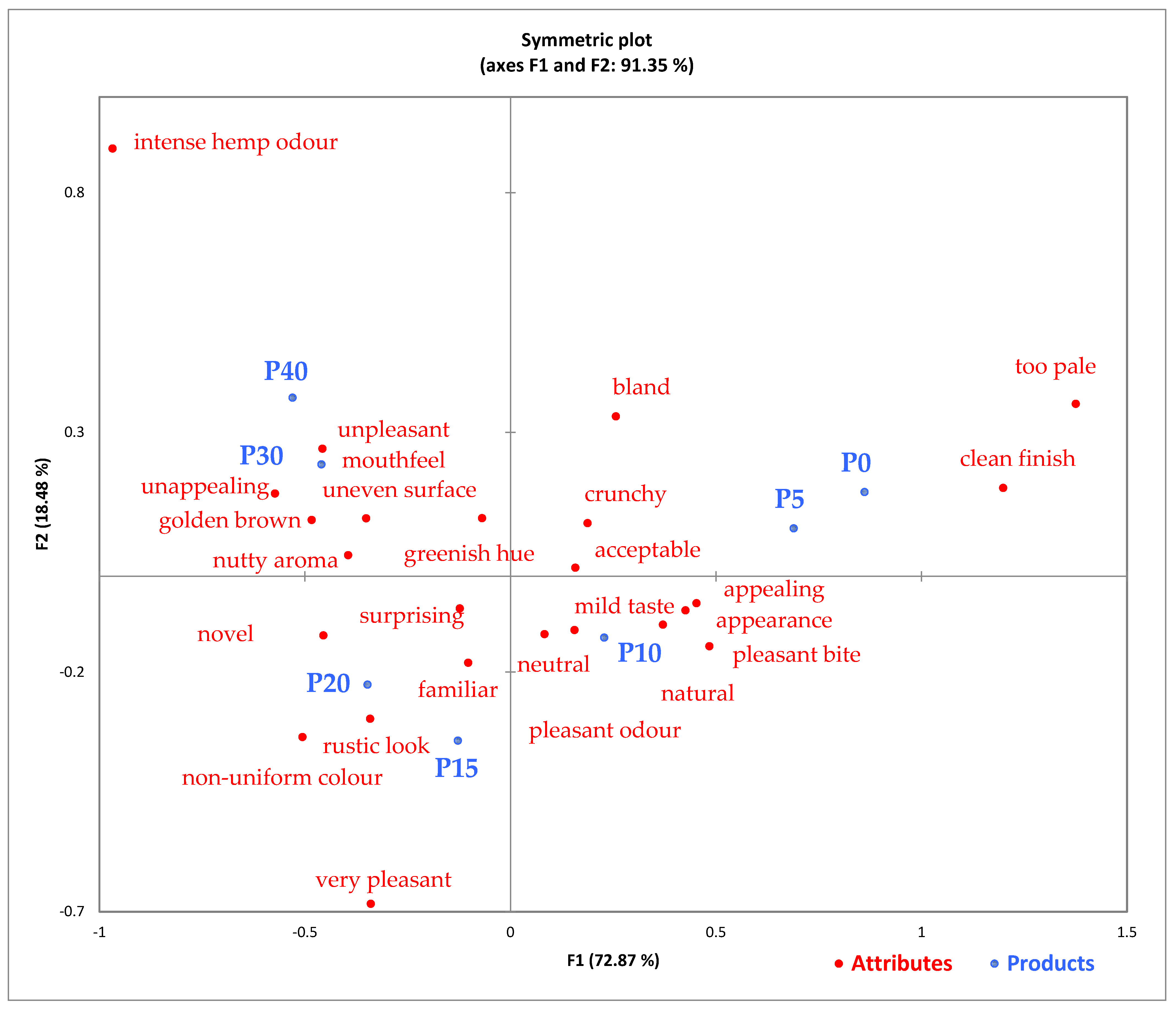
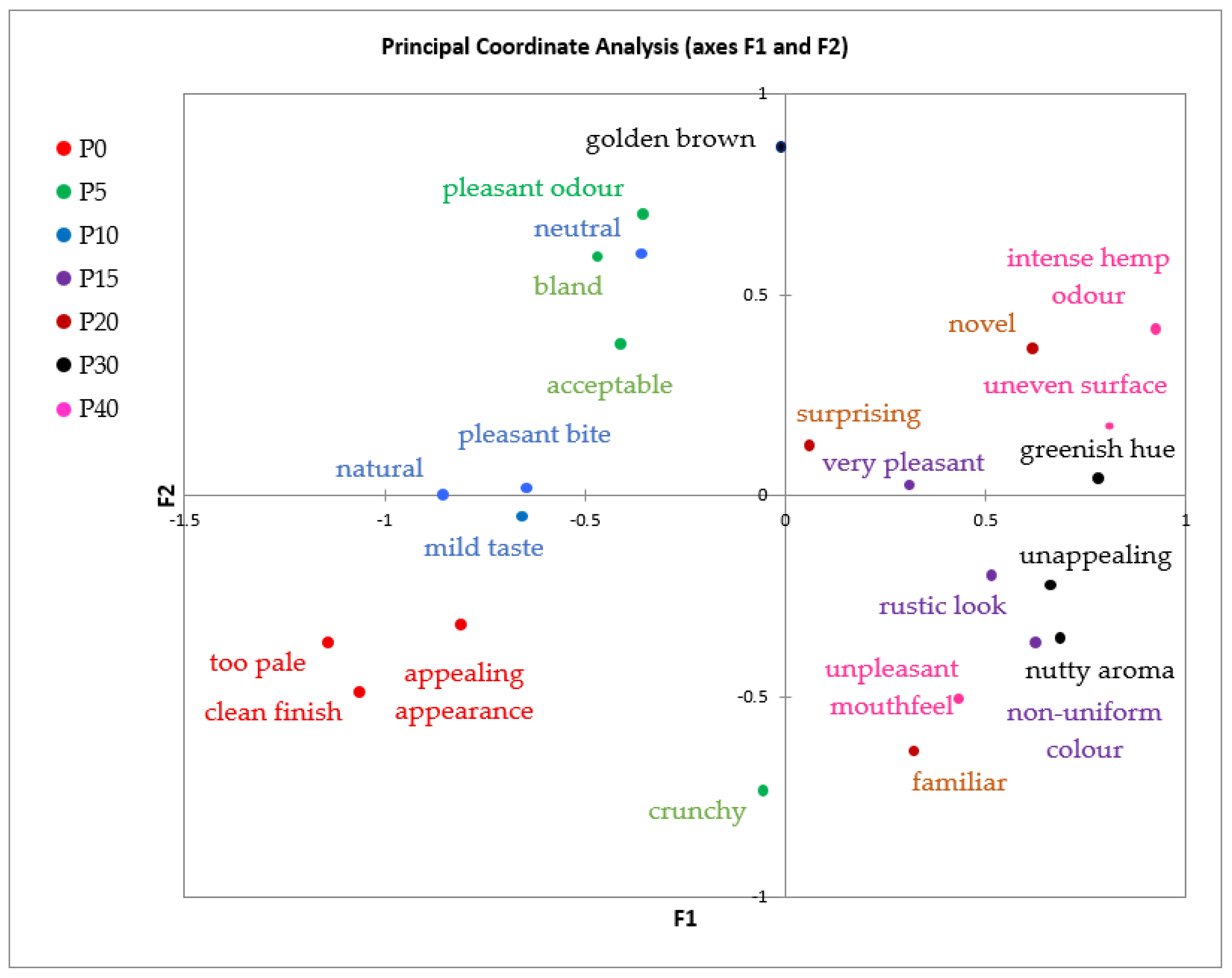

| Raw Materials, g | Hemp Seed Cake Level, % (% Replacement of Wheat Flour) | ||||||
|---|---|---|---|---|---|---|---|
| 0% | 5% | 10% | 15% | 20% | 30% | 40% | |
| Wheat flour | 70.0 | 66.5 | 63.0 | 59.5 | 56.0 | 49.0 | 42.0 |
| Hemp seed cake | 0.0 | 3.5 | 7.0 | 10.5 | 14.0 | 21.0 | 28.0 |
| Vegetable oil | 2.5 | 2.5 | 2.5 | 2.5 | 2.5 | 2.5 | 2.5 |
| Salt | 1.5 | 1.5 | 1.5 | 1.5 | 1.5 | 1.5 | 1.5 |
| Attribute Category | CATA Attributes |
|---|---|
| Visual Aspect | Appealing appearance, uneven surface, rough crust, cracks on surface, attractive shape, rustic look |
| Color | Too pale, golden brown, dark brown, greenish hue, uniform color, non-uniform color |
| Odor | Intense hemp odor, weak hemp odor, nutty aroma, earthy odor, roasted smell, floury smell, pleasant odor |
| Flavor | Mild taste, bitter, nutty, fermented, salty, savoury, bland, unpleasant taste |
| Aftertaste | Lingering bitterness, nutty aftertaste, clean finish, herbal aftertaste, unpleasant residual taste |
| Texture | Hard, crunchy, crumbly, dry, gritty, compact, dense, pleasant bite, unpleasant mouthfeel |
| Overall Acceptability | Very pleasant, acceptable, neutral, slightly unpleasant, unpleasant |
| Emotional Response | Comforting, familiar, novel, surprising, strange, natural, unappealing |
| Pretzels Sample | Moisture (%) | Acidity (Degrees) | Water Activity (aw) |
|---|---|---|---|
| P0 | 12.48 ± 0.24 a | 1.67 ± 0.04 a | 0.524 ± 0.004 a |
| P5 | 12.44 ± 0.17 a | 1.98 ± 0.02 b | 0.501 ± 0.005 ab |
| P10 | 12.37 ± 0.31 a | 2.24 ± 0.03 c | 0.479 ± 0.006 b |
| P15 | 12.05 ± 0.21 ab | 2.36 ± 0.06 cd | 0.465 ± 0.003 bc |
| P20 | 11.76 ± 0.29 ab | 2.54 ± 0.05 d | 0.453 ± 0.005 c |
| P30 | 11.62 ± 0.23 ab | 2.63 ± 0.02 de | 0.432 ± 0.002 d |
| P40 | 11.36 ± 0.28 b | 2.71 ± 0.03 e | 0.428 ± 0.006 de |
| Pretzels Sample | Protein (%) | Fat (%) | Fiber (%) | Ash (%) | Carbohydrate (%) | Energy (kcal/100 g) | Energy from Protein (%) |
|---|---|---|---|---|---|---|---|
| P0 | 7.49 ± 0.37 a | 3.13 ± 0.16 a | 0.90 ± 0.04 a | 1.79 ± 0.09 a | 74.20 ± 3.71 a | 354.93 ± 3.24 c | 8.44 ± 0.35 a |
| P5 | 8.13 ± 0.41 b | 3.36 ± 0.17 ab | 2.26 ± 0.11 b | 1.98 ± 0.10 ab | 71.83 ± 3.59 ab | 350.08 ± 3.17 bc | 9.29 ± 0.42 ab |
| P10 | 8.77 ± 0.44 bc | 3.59 ± 0.18 bc | 3.62 ± 0.18 c | 2.16 ± 0.11 b | 69.48 ± 3.47 b | 345.31 ± 2.45 b | 10.16 ± 0.15 b |
| P15 | 9.41 ± 0.47 c | 3.83 ± 0.19 cd | 4.98 ± 0.25 d | 2.35 ± 0.12 bc | 67.38 ± 3.36 bc | 341.63 ± 3.05 b | 11.02 ± 0.53 b |
| P20 | 10.05 ± 0.50 cd | 4.06 ± 0.20 de | 6.34 ± 0.32 e | 2.53 ± 0.13 cd | 65.25 ± 3.26 cd | 337.74 ± 2.11 ab | 11.90 ± 0.27 b |
| P30 | 11.34 ± 0.57 d | 4.52 ± 0.23 ef | 9.06 ± 0.45 f | 2.90 ± 0.15 de | 60.56 ± 3.03 de | 328.28 ± 1.58 a | 13.82 ± 0.61 c |
| P40 | 12.62 ± 0.63 e | 4.98 ± 0.25 f | 11.78 ± 0.59 g | 3.27 ± 0.16 e | 55.99 ± 2.80 e | 319.26 ± 2.45 a | 15.81 ± 0.41 d |
| Pretzels Sample | Total Polyphenol Content (mg GAE/kg) | Total Flavonoid Content (mg GAE/kg) | DPPH (mg Trolox/kg) | ABTS (mg Trolox/kg) |
|---|---|---|---|---|
| P0 | 115.28 ± 2.14 a | 63.40 ± 1.21 a | 194.42 ± 2.75 a | 486.05 ± 6.9 a |
| P5 | 193.54 ± 2.28 b | 107.45 ± 1.69 b | 285.75 ± 4.14 b | 714.38 ± 10.4 b |
| P10 | 262.15 ± 1.64 c | 145.29 ± 1.48 c | 367.15 ± 3.35 c | 917.88 ± 8.4 c |
| P15 | 314.93 ± 2.05 d | 175.40 ± 1.57 d | 453.46 ± 3.52 d | 1 133.65 ± 8.8 d |
| P20 | 352,41 ± 1.78 e | 198.82 ± 1.42 e | 492.57 ± 4.21 e | 1 231.43 ± 10.5 e |
| P30 | 412.71 ± 1.64 f | 232.47 ± 1.51 f | 576.34 ± 4.67 f | 1 440.85 ± 11.7 f |
| P40 | 467.45 ± 2.11 g | 262.28 ± 1.68 g | 658.89 ± 5.34 g | 1 647.23 ± 13.3 g |
 | 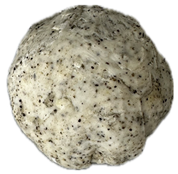 | 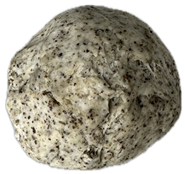 | 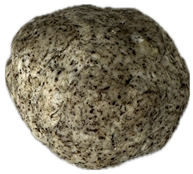 |
 | 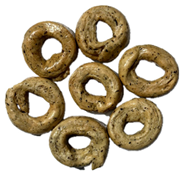 | 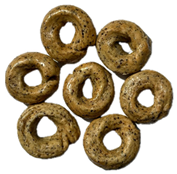 | 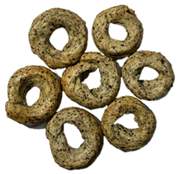 |
| P0 | P5 | P10 | P15 |
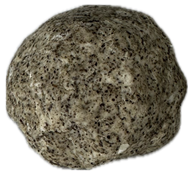 |  | 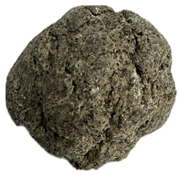 | |
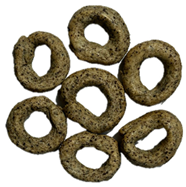 | 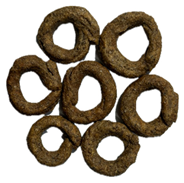 | 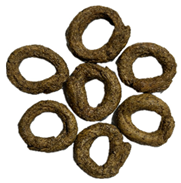 | |
| P20 | P30 | P40 |
| Pretzels Sample | P0 | P5 | P10 | P15 | P20 | P30 | P40 |
|---|---|---|---|---|---|---|---|
| Pretzel dough | |||||||
| L* | 97.40 ± 1.27 e | 90.25 ± 0.58 de | 87.06 ± 0.83 d | 77.35 ± 0.48 c | 62.34 ± 0.52 b | 59.23 ± 0.75 ab | 54.21 ± 0.59 a |
| a* | −1.98 ± 0.04 b | −2.42 ± 0.01 a | −0.94 ± 0.02 c | 3.56 ± 0.02 g | 0.36 ± 0.01 f | −0.12 ± 0.01 d | 0.19 ± 0.01 e |
| b* | 17.16 ± 0.31 c | 12.51 ± 0.23 a | 14.74 ± 0.45 b | 21.66 ± 0.68 d | 12.24 ± 0.29 a | 16.79 ± 0.34 bc | 12.77 ± 0.28 a |
| ΔE | - | 8.54 ± 0.11 a | 10.67 ± 0.14 b | 21.28 ± 0.21 c | 35.48 ± 0.54 d | 38.21 ± 0.29 e | 43.46 ± 0.63 f |
| WI | 82.53 ± 0.98 ef | 83.95 ± 0.85 f | 80.36 ± 1.02 e | 68.45 ± 0.75 d | 60.39 ± 0.67 c | 55.90 ± 0.68 b | 52.46 ± 0.46 a |
| Final baked products | |||||||
| L* | 82.39 ± 0.95 f | 70.59 ± 0.85 e | 63.64 ± 0.86 de | 57.81 ± 0.65 d | 47.82 ± 0.25 c | 35.67 ± 0.25 b | 27.15 ± 0.32 a |
| a* | 3.08 ± 0.04 a | 5.84 ± 0.02 b | 3.64 ± 0.02 ab | 6.3 ± 0.05 c | 2.91 ± 0.01 a | 8.99 ± 0.11 d | 6.39 ± 0.35 c |
| b* | 27.64 ± 0.21 b | 29.98 ± 0.34 c | 26.90 ± 0.31 ab | 36.46 ± 0.45 d | 25.53 ± 0.28 a | 29.31 ± 0.65 c | 29.62 ± 0.54 c |
| ΔE | - | 12.34 ± 0.16 a | 18.77 ± 0.09 b | 26.31 ± 0.21 c | 34.63 ± 0.33 d | 47.12 ± 0.58 e | 55.37 ± 0.61 f |
| WI | 67.08 ± 0.84 g | 57.59 ± 0.78 f | 54.62 ± 0.65 e | 43.88 ± 0.38 d | 41.83 ± 0.58 c | 28.73 ± 0.32 b | 21.09 ± 0.17 a |
Disclaimer/Publisher’s Note: The statements, opinions and data contained in all publications are solely those of the individual author(s) and contributor(s) and not of MDPI and/or the editor(s). MDPI and/or the editor(s) disclaim responsibility for any injury to people or property resulting from any ideas, methods, instructions or products referred to in the content. |
© 2025 by the authors. Licensee MDPI, Basel, Switzerland. This article is an open access article distributed under the terms and conditions of the Creative Commons Attribution (CC BY) license (https://creativecommons.org/licenses/by/4.0/).
Share and Cite
Capcanari, T.; Covaliov, E. Development of Clean-Label Protein- and Fiber-Enriched Dry Pretzels Using Hemp Seed By-Products. Foods 2025, 14, 3925. https://doi.org/10.3390/foods14223925
Capcanari T, Covaliov E. Development of Clean-Label Protein- and Fiber-Enriched Dry Pretzels Using Hemp Seed By-Products. Foods. 2025; 14(22):3925. https://doi.org/10.3390/foods14223925
Chicago/Turabian StyleCapcanari, Tatiana, and Eugenia Covaliov. 2025. "Development of Clean-Label Protein- and Fiber-Enriched Dry Pretzels Using Hemp Seed By-Products" Foods 14, no. 22: 3925. https://doi.org/10.3390/foods14223925
APA StyleCapcanari, T., & Covaliov, E. (2025). Development of Clean-Label Protein- and Fiber-Enriched Dry Pretzels Using Hemp Seed By-Products. Foods, 14(22), 3925. https://doi.org/10.3390/foods14223925







